Growing vegetables in the house can be interesting and exciting. You can grow them vertically using a trellis if you have a small space. Besides, a lot of vining vegetable plants will need a trellis for support.
Vegetables like tomatoes, cucumbers, squashes, peas, beans, pumpkins, gourds, etc., need a trellis for robust and healthy growth. Most have trailing growth habits with long vines, and the trellis supports the vines, keeps them above ground level, and keeps them in shape.
Growing vegetables on a trellis have many plus points. This article will share the benefits of growing vegetables on a trellis, vegetables that will need a trellis, and some care tips for the veggies growing on a trellis.
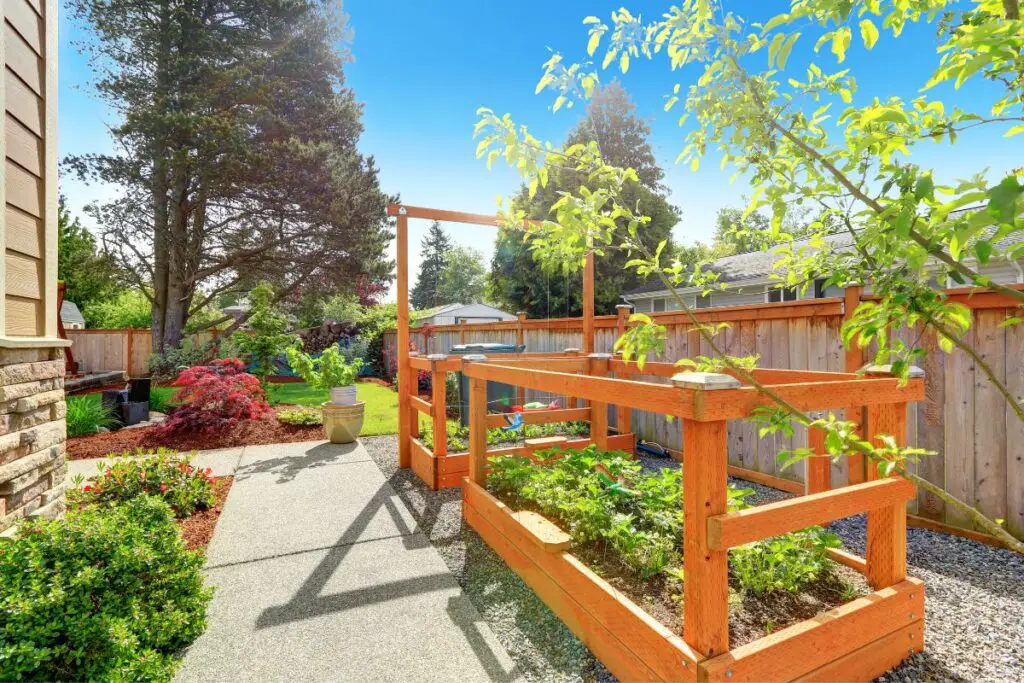
Benefits of growing vegetables on a trellis
Growing plants on a trellis have a lot of advantages:
1. More space and more vegetables
A trellis requires a very short space.
If your garden doesn’t have enough room, get trellises that fit in a small space and grow vegetables like cucumbers or tomatoes.
You can get a lot of vegetables.
Growing vegetables on a trellis give you maximum food from minimal space.
2. Fewer chances of infestations
Growing plants on a trellis improve air circulation, preventing pathogens and pests from attacking the plant.
Proper air circulation prevents high humidity and prolonged moist conditions.
That is why the fungus and insects loiter less around the trellised plants.
3. Easy harvest
Harvesting the vegetables on trellises is easier than those growing on the ground.
The vegetables remain clean.
There is no putting extra effort into cleaning and washing the vegetables.
You don’t have to bend and dig up the soil to get the vegetables from under the ground.
You can even notice the conditions of the vegetables.
4. Clean and straight vegetables
As mentioned before, there is no scene of putting extra effort into cleaning the vegetables.
Besides, you receive straight vegetables.
Under the ground, the vegetables sometimes become distorted due to soil pressure and close planting.
Such things don’t occur in a trellis.
The vegetables get enough space to grow properly, and thus, they remain in their shape.
5. Support
The vegetable plants having vines get support with the help of a trellis.
You can guide the vines to grow in a particular direction.
The vines won’t fall over and stroll over the ground.
The vines will get proper support in a trellis, stay over there, and keep growing.
Common types of trellis
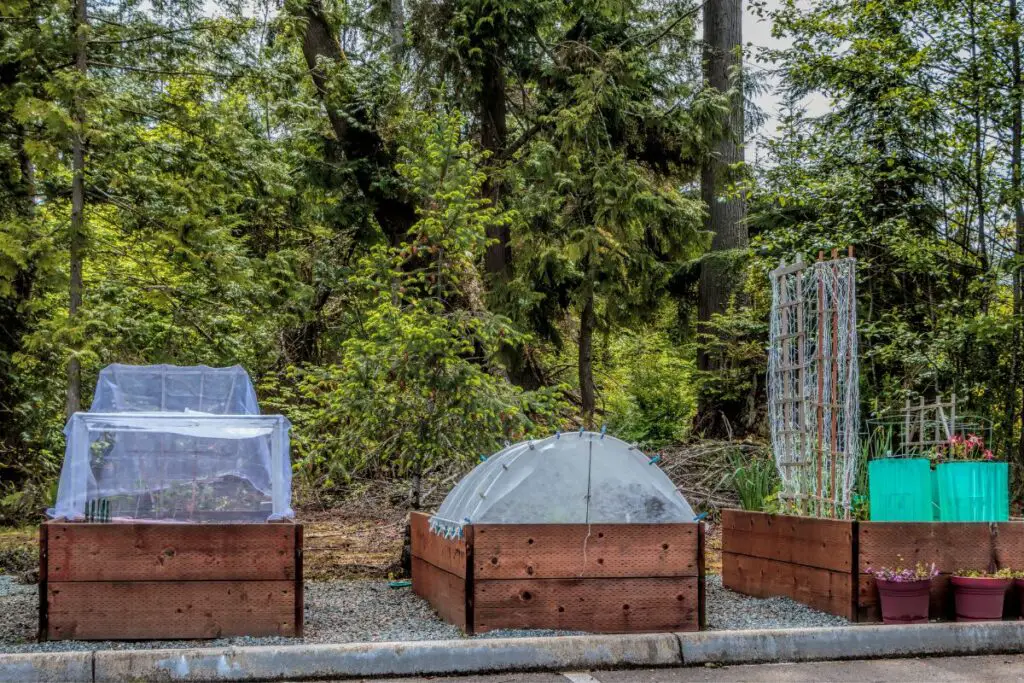
There are multiple types of trellises, and different trellises have different features and functions.
1. Arches, arbors, and tunnels
These trellises add elegance and design to your garden.
Arches and arbors are made of wood which you can paint later on.
But, they are also available in plastic and steel.
You can add stylish arches and arbors between the raised beds and decorate your garden.
Looking for gardening supplies? We have tested 100's of products before recommending them to you guys. Check out our best pick below:
| Image | Gardening Supplies | Best Price? |
|---|---|---|
 Top
Top Top
Top | Raised Garden Bed Kit | Check On Amazon |
 | XLUX Soil Moisture Meter, Plant Water Monitor, Soil Hygrometer Sensor for Gardening, Farming, Indoor and Outdoor Plants, No Batteries Required | No Results |
 Top
Top Top
Top | 82 Pcs Garden Tools Set and Extra Succulent Tools Set | Check On Amazon |
 | Joeys Garden Expandable Garden Hose with 8 Function Hose Nozzle, Lightweight Anti-Kink Flexible Garden Hoses, Extra Strength Fabric with Double Latex Core, (50 FT, Black) | No Results |
 Top
Top Top
Top | Dual Chamber Compost Tumbler | Check On Amazon |
 Top
Top Top
Top | Sunnyglade Plant Stakes | Check On Amazon |
 Top
Top Top
Top | Organic Cold Pressed Neem Seed Oil | Check On Amazon |
 Top
Top Top
Top | Mighty Mint Gallon :-Insect and Pest Control Peppermint Oil | Check On Amazon |
 Top
Top Top
Top | Scotts DiseaseEx Lawn Fungicide | Check On Amazon |
 Top
Top Top
Top | Jacks Classic 20-20-20 All Purpose Fertilizer | Check On Amazon |
 Top
Top Top
Top | 30,000 Seeds Pollinator Attracting Wildflower Mixture | Check On Amazon |
 Top
Top Top
Top | Survival Vegetable Seeds Garden Kit-Over 16,000 Seeds | Check On Amazon |
2. Flat trellises
These trellises add definition to a particular space.
The trellises are freestanding, and you can anchor them to a particular location in your garden, windows, walls, or posts.
They come in lattice, metals, and even mesh.
3. Obelisks, towers, and pyramids
These trellises are great for both functional and decorative purposes.
They give proper support to the vegetables and add aesthetic value to your garden.
You can even make one on your own using bamboo or twine.
4. A-frame and tripods
You can either buy them or build them.
In an A-frame, join two flat sides at the top to form an A shape.
These trellises are very strong and ideal for peas, beans, melons, squashes, etc.
In tripods, you join three long sticks or bamboo and join them with extra woods for support.
5. Wire mesh
These are strong due to the presence of wood and stainless steel.
They can hold vegetables like gourds, cucumbers, peas, runner beans, etc.
6. Posts, netting, and twine
Posts and netting are the basic types of trellises.
They are ideal for vegetables that grow vines in the upward direction.
7. Bamboo teepees
These are very classy to look at and very easy to build.
Teepees are great for vegetables like peas, beans, and cucumbers.
14 Vegetables that need a trellis to grow
Before you buy trellises, plan what vegetables you want to grow.
Different vegetables will need different trellises.
For average or lightweight veggies like pole beans, buy post trellises where the vines will grow holding the post.
For cucumbers, use wire mesh trellises to support their tendrils and weight.
Now, let’s see which vegetables will require a trellis to grow.
1. Cucumbers
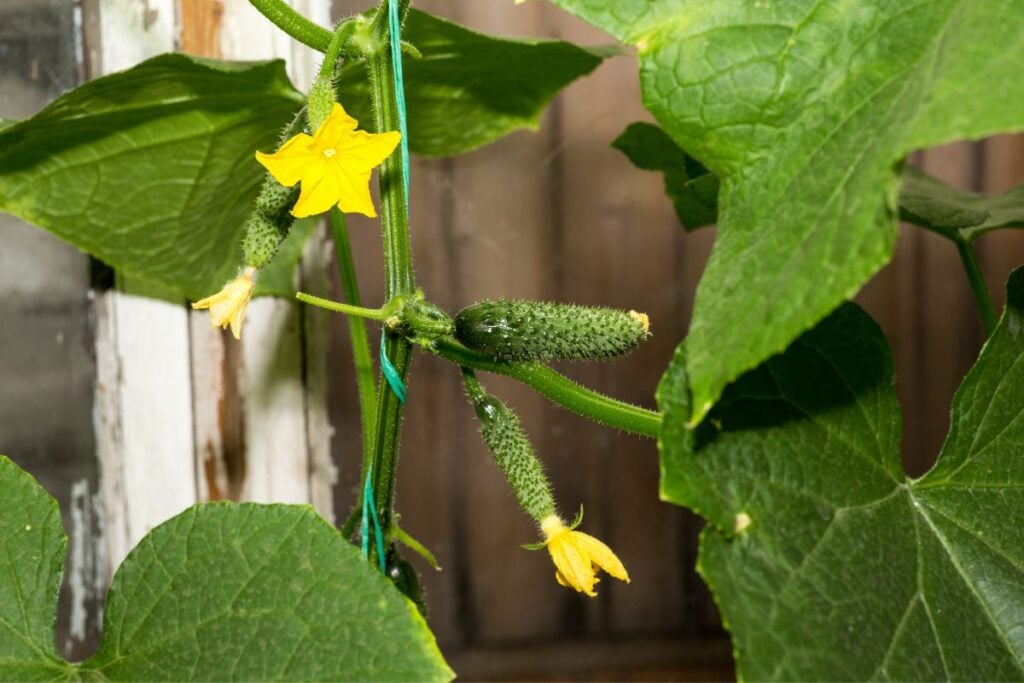
Cucumbers are easy to grow on a trellis.
The vine variety needs a trellis for support.
A single plant can produce lots of cucumbers.
The vines are short, around 8 feet, but still require support.
So, an A-frame or cage trellis with mesh wire would be ideal.
Since the plant will receive lots of air circulation on the trellis, the plant won’t have any infestations.
So, you get many healthy cucumbers.
Basic care:
- Plant cucumbers at a location receiving 6-8 hours of sunlight.
- Either place the trellis in a proper position while planting or later when the plant reaches 4-6 inches and has vines.
- If you place and anchor the trellis during planting, ensure the vines can hold the bars from the beginning.
- Gently wrap the tendrils in the trellis so they can grow in a particular direction.
- Ensure that the soil remains well-drained and rich in nutrients.
- Sow the seeds in mid-spring and again in late summer.
- Since cucumbers are heavy, use a sturdy trellis to handle the weight.
- Water the plants regularly, avoiding the foliage.
2. Tomatoes
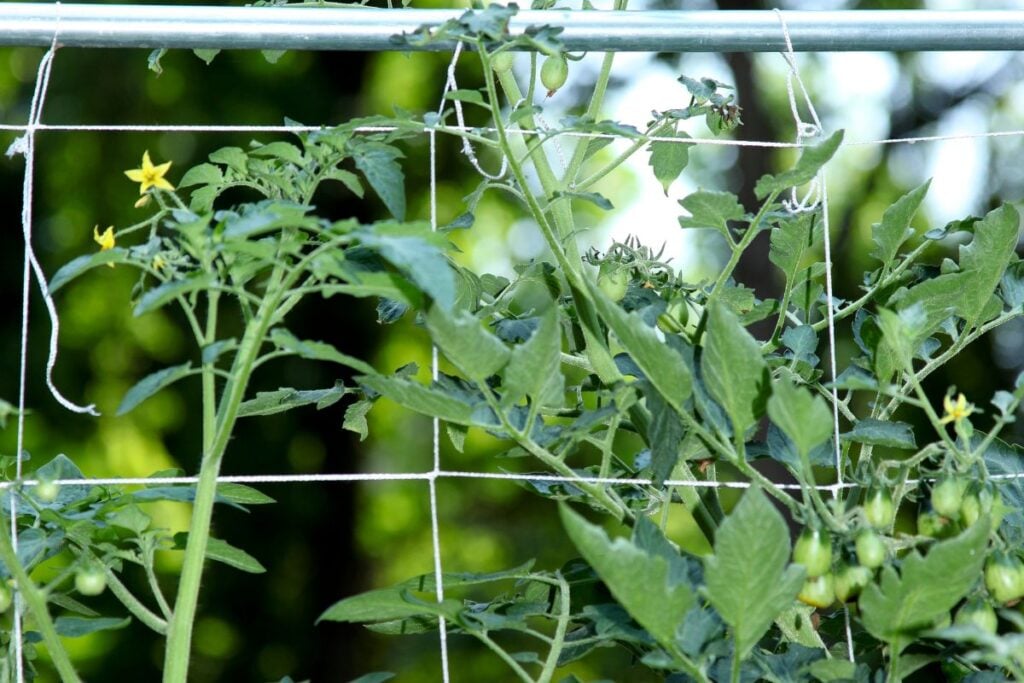
Indeterminate tomatoes will require a trellis to grow.
The vines of tomatoes grow only 12 feet.
Go for a wooden trellis made of cedar or a metal trellis with stainless steel mesh.
Try cages, cone-shaped trellis, or tripods. Make sure the trellis is long enough.
Otherwise, the tomatoes will spill over the top, and the vines will get harmed.
Basic care:
- Once the plant has vines, position the trellis and secure the base.
- Tie the vines lightly because tomatoes don’t have tendrils to hold the bars.
- Make sure the vegetable gets enough sunlight.
- Plant them in well-drained fertile soil and water them regularly.
3. Squash
Squashes are aggressive and take up a lot of space in gardens.
A trellis can help to produce lots of squashes in a limited space.
Squashes also require a lot of air circulation.
You save your plants from infestations when growing them on a trellis.
Since squashes are aggressive and heavy, the trellis has to be strong enough to hold them.
One made of vinyl, metal, or iron would be great.
The winter squashes are heavier than the summer squashes and reach 20 feet vines.
Some good trellis options are arbors or A-frames.
Basic care:
- Since the vines will keep growing in the air, they will dry faster. Water them regularly to maintain the moisture levels. Squashes will require full sun to grow but not harsh sunlight.
- Use jute twines to tie them lightly with the trellis.
- Don’t keep squashes close to other plants. Since they take up a lot of space, they might interfere with other plants’ growth.
- Squashes will crawl and get hold of whatever they get first. So, train it and give it a direction to grow. Wrap the tendrils into the trellis so that they don’t catch anything else for growing.
4. Pumpkins
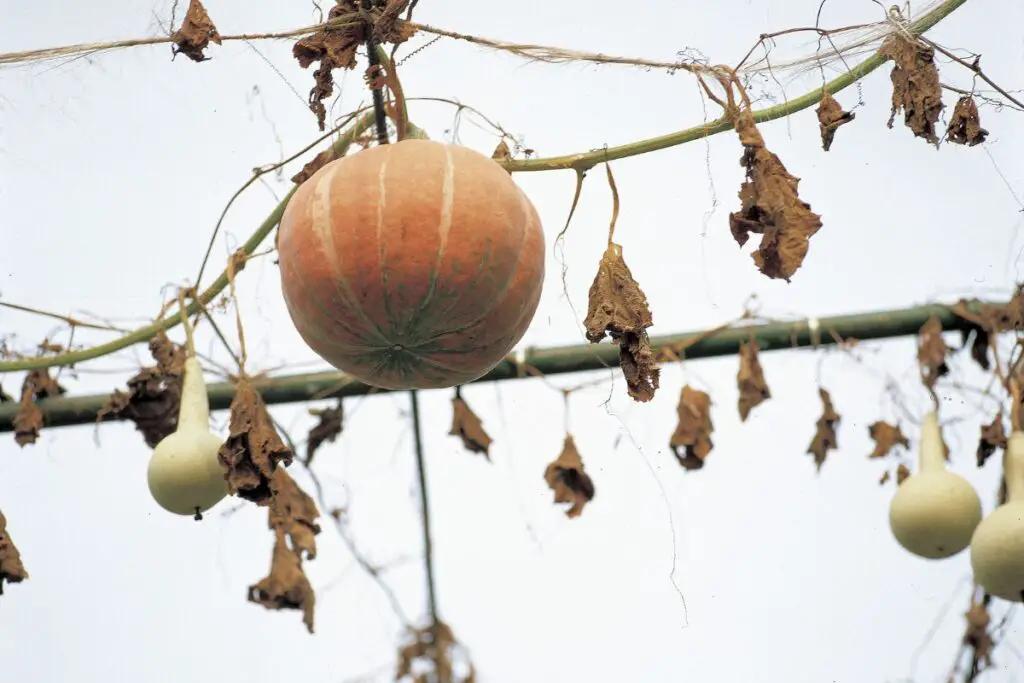
Pumpkins belong to the squash family and behave the same way as they do.
The only difference is pumpkins are bigger and heavier than squashes.
So, they need a strong trellis for support.
Their vines are 10-20 feet long and need to be guided for growing in a particular direction.
They will latch on easily.
Basic care:
- Plant them in well-drained, rich soil.
- When the plant grows vines, put the trellis properly and train them to catch the trellis.
- If growing large pumpkins, give them extra support with a sling or hammock. Otherwise, they will break and fall off the vines.
5. Pole Beans
Pole beans are climbing vegetables with vines around 10-20 feet.
So, they need a post trellis to climb and support their vines.
You can either go for metals or lattice woods.
In the case of woods, you can screw the base to the fence.
But just because pole beans are light doesn’t mean you can use a weightless trellis.
Arbors and arches would be fine because the trellis needs to be strong enough to handle winds.
Netting, posts, or trellis made of stainless steel would work well for pole beans.
Basic care:
- Train the vines a little to help them hold the bars of trellises.
- Plant the pole beans in well-drained, rich soil at a location where the sunlight is full, and temperatures are around 60°F.
6. Asparagus beans
If you want small beans for a small trellis, go for the Asparagus beans.
They grow only 6-10 feet vines.
But they will take time to grow.
Since they are shorter, the less durable trellis can also hold them easily.
You can try plastic or metal arbors. Guide the vines and let them grow.
Basic care:
- Make sure to plant them under the full sunlight in well-drained fertile soil.
- Plant the seeds and then set the trellis near them where the vines can catch them and start growing, holding the trellis.
7. Tomatillos
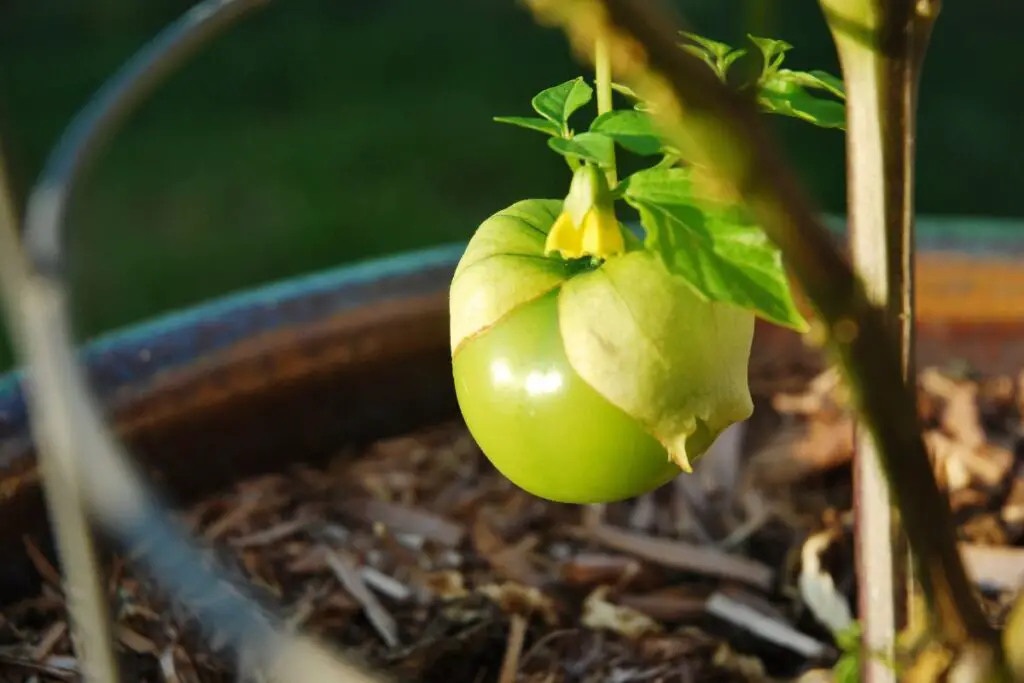
Tomatillos are fruits but can be considered vegetables.
They are Mexican husk tomatoes and can be consumed raw and cooked like tomatoes.
As the plant grows, the branches will snap if the vines don’t have the support of a trellis.
So, it is necessary for Tomatillos.
The vines can grow about 7-8 feet only.
So, take a short trellis but a strong one.
A 3-4 feet trellis is fine if you have standard vegetables, especially the cage one.
But, if you have vine Tomatillos, you need a 5-6 foot trellis.
Basic care:
- Tie the vines to the trellis to prevent falling or snapping in the wrong direction. Since Tomatillos don’t have climbing habits, train them like tomatoes.
- Place the trellis during the early growing season so the vines can get support before the branches fall and snap off.
- These plants are tough and can thrive under full sun and partial shade.
8. Peas
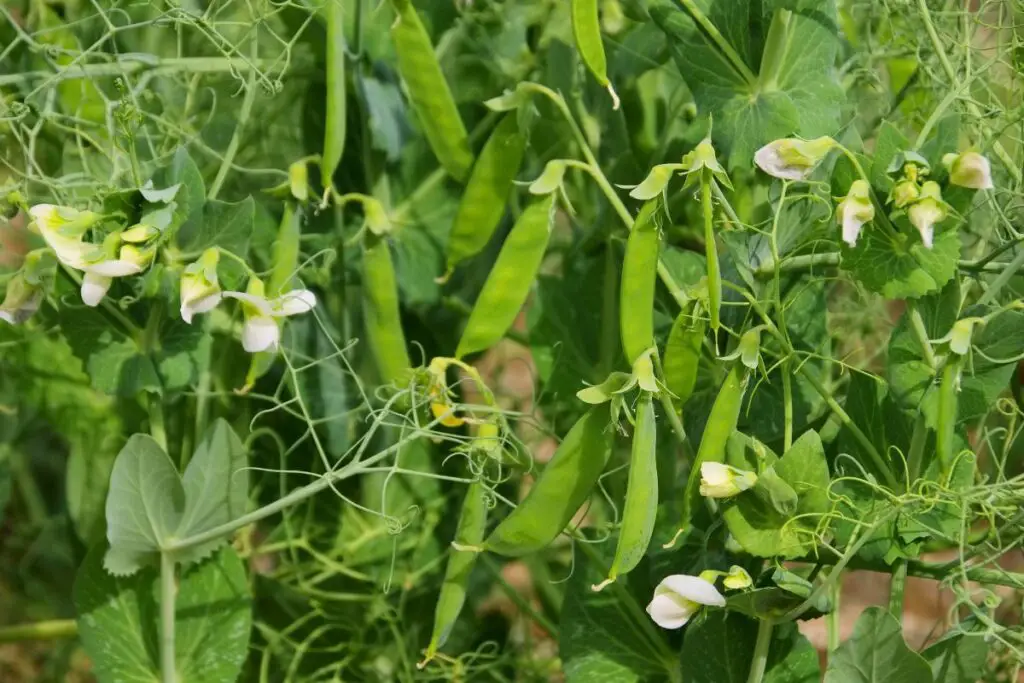
Peas are available in both bush and climbing varieties.
You will need a trellis if you have the climbing variety.
The climbing Peas will start growing at your neighbor’s houses if they don’t get support.
So, trellises are essential for them.
Trellis also protects them from diseases and rotting,
which is quite common on the ground.
Since Peas have climbing habits, the best type of trellis would be something tall where the tendrils wrap can around and keep growing, holding the bars of the trellis.
A trellis made of twine, string, or mesh is fine. Avoid woods.
You can try obelisks and A-frames.
Basic care:
- Give Peas support with a trellis and guide them to grow in and around the trellis only. Wrap the tendrils around the trellis.
- Once the plant grows vines, position the trellis as required and secure the base.
- Plant the peas in well-drained soil under the full sun.
- Add mulch around the plant for moisture retention and weed growth when the plant reaches 6 inches.
9. Loofah/Luffa
Luffa is a kind of Sponge gourd with vines.
They are a little heavier than cucumbers, so they need a heavier trellis for support.
The vines of Luffa are very long, around 30 feet.
So, you need to choose a trellis that is quite big in height or width.
Sometimes, the growth of the vines can get out of control.
That is why trellises are important.
Luffa doesn’t rot or discolor when grown on a trellis because they get lots of air and sun.
Basic care:
- Since the vines are so large, check their growth patterns. Train them or give them enough space for re-routing in their growth process.
- Plant Luffa under the full sun in well-drained fertile soil and keep them moist.
10. Sweet potatoes
Sweet potatoes are famous and the same as normal potatoes but taste sweeter.
As we all know, potatoes are always grown under the ground.
But, you can grow sweet potatoes on trellises above the ground.
It makes harvest easy and clean.
Sweet potato vines spread all over the ground around 20 feet.
But, you can guide them to grow over the trellis vertically to save space.
Since it is a crawler, it will require some guidance initially.
Once the potatoes get accustomed to your training, they will grow toward the trellis bars.
Basic care:
- Plant sweet potatoes under the full sun in well-drained humus-rich soil.
- The vines of sweet potatoes don’t have tendrils, so you must tie them lightly with the bars.
- Keep the soil moist for the first 60 days, and then water deeply only once a week. Reduce as the time for harvest approaches.
11. Chayote
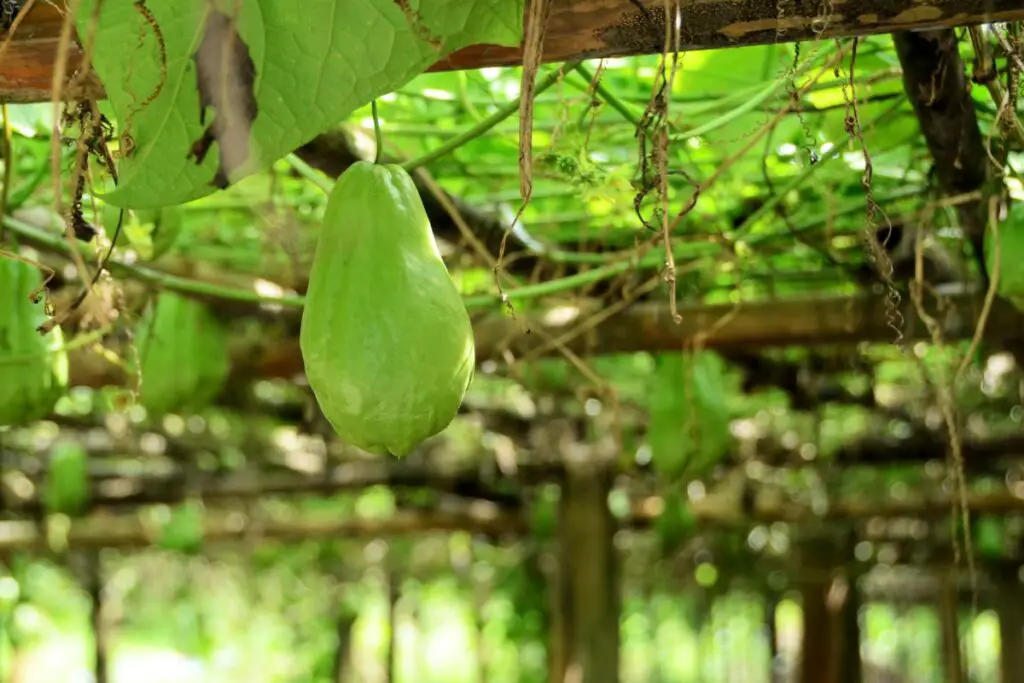
Also called mirliton or Choko, Chayote is a type of squash that belongs to the gourd family.
The vegetable is pear-shaped, and the plant has climbing habits.
Tall vertical trellises would be a good choice for these plants.
The vines will get hold of the trellis and keep climbing upwards.
You only need to wrap them a bit to show the direction of growth.
Basic care:
- The plant grows best in a warm environment. Each plant can produce around 50-100 vegetables. So, make sure the trellis is sturdy to hold the vegetables.
- Plant them under the full sun in well-drained, sandy, or loamy soil. Give them 1 inch of water per week. Once it grows vines, place the trellis in its proper position.
- You can also place the trellis at the time of planting. Place it so that the vines can get hold of them from the beginning.
12. Gourds
There are multiple gourd types, like a bitter, ornamental, edible, sponge, and many more.
Gourds have very long vines ground about 40 feet.
But you can prune and keep them only around 10 feet.
Since they grow at such lengths, an arbor trellis would be great.
You can create gateways and give the garden an aesthetic appearance.
Basic care:
- Gourds grow best under the full sun in warm areas. The soil must be well-drained and fertile.
- Train the stems or vines to grow in the upward direction holding the trellis.
13. Cantaloupes
They are the relatives of melons and are the same as cucumbers, squashes, and gourds.
Their size and growth habits take up a lot of space.
So, they will require a trellis to produce the maximum food from minimal space.
Cantaloupe vines grow about 4-7 feet.
A short-sized trellis would be great.
But it must be strong enough to hold the heavy cantaloupes.
The trellis has to be tall and wide, like 8 feet high and 15 feet wide.
An arch trellis would be great.
Arches are made of wood and are quite heavy and sturdy.
They are capable of holding the weight of these melons.
Besides, your garden will get a stylish vegetable gate.
Basic care:
- Tie the vines with the bars lightly when they become long enough for support to prevent falling off due to heavyweight.
- Also, wind the vines around the bars to give them support and growth direction.
- Place cantaloupes and the trellis under the full sun and in warm climates.
14. Malabar spinach
It is a leafy green vegetable with creeping vines growing about 30 feet.
So, they are very much suitable for growing on trellises.
Once they get the support of a trellis, they will stick to the trellis instead of crawling over the ground, which is their natural feature.
Basic care:
- Though it grows very long, you can prune and keep it short, around 6-12 feet.
- They grow best in warm climates under the full sun or partial shade to grow at their best.
How do I choose the right trellis for my vegetables?
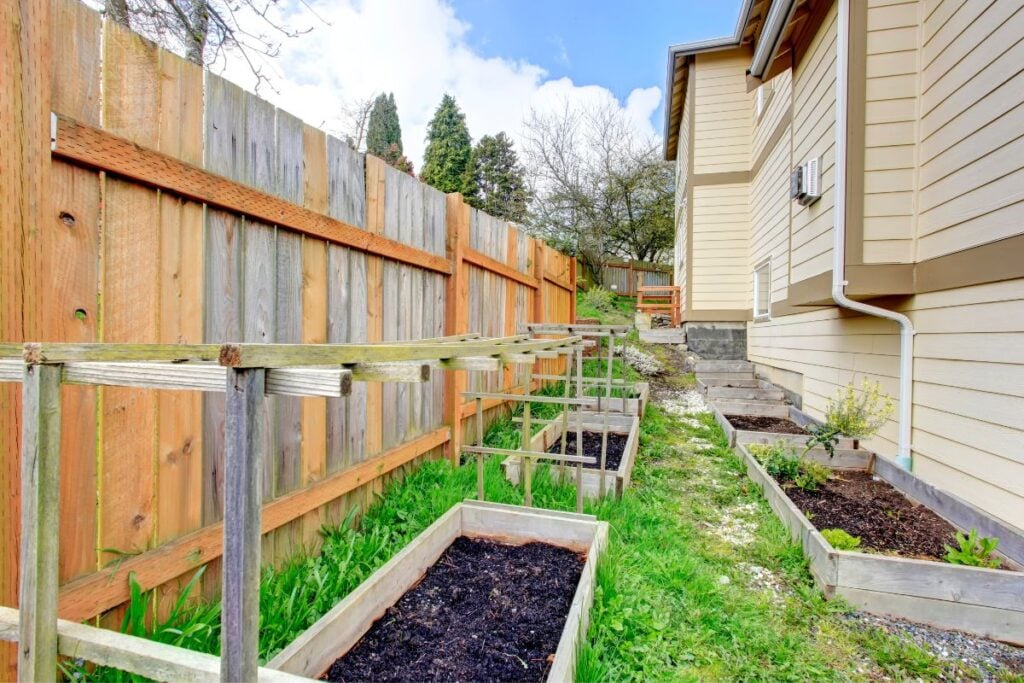
Trellis have various shapes and sizes.
Depending on the vegetable type, it is not easy to choose the right one, especially if you are a beginner.
Choose a trellis that suits your garden and the vegetables to take gardening to the next level.
Here are a few tips for selecting the right one:
- Stakes are easy to build and handle. Make one or buy one made of metal, wood, or bamboo.
- A-frames are made of wood and wire mesh. Since they are strong, they are ideal for heavy vegetables like squashes, pumpkins, cucumbers, etc.
- Teepees are made with bamboo and are very flexible and resistant. It is good for vegetables like beans and peas.
- A flat or fence-type trellis is strong and can handle heavy vegetables like squashes.
- Cages are good for vegetables that are heavier than average.
- Clotheslines are ideal for tall plants with climbing plants that need proper direction to grow.
- Arches are tough to build, but they are sturdy and look great in the garden, especially as gateways. You get a chance to walk underneath the hanging veggies.
Final thoughts
Growing vegetables on trellises are quite fun. Besides, you get a lot of benefits from it, like no rotting or infestations, proper air circulation, and healthy plants and vegetables.
You get the maximum amount of food from the minimum space. Since growing veggies vertically on trellises requires small space, you can grow some plants on trellises.
There are many types of trellises like arbors, arches, tripods, a-frames, flat surfaces made of mesh wires, bamboo teepees, and many more.
You can also grow other vegetables except those mentioned in this article, like melon types, jicama, zucchini, bottle gourds, bitter gourds, etc. But those mentioned in this article are the most common vegetables that need a trellis to grow.
Reference: Trellises and cages to support garden vegetables, The behavioral ecology of climbing plants, Trellising and Training Basics, Trellis Solultions.
